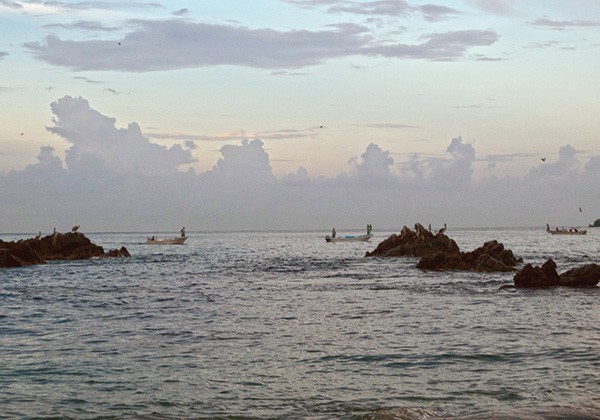My first night in Zihuatanejo, a handsome Mexican businessman assured me that cartel kidnapers had no interest in me. They were after known quantities, he said, who had plenty of family money. I felt relieved, as both the Canadian and U.S. governments currently advise against nonessential travel to Guerrero state, with the exception of tourist zones. Zihuatanejo is definitely a tourist zone. But still, reading the warnings had put me on edge.
Over the next few days, I discovered that many tourists and expats find this old fishing town on Mexico's Pacific coast absolute paradise. I met a half dozen Americans who'd bought condos in Zihua, as locals call it, or were in the process of getting permanent visas. As I wandered the beach and town, I contemplated why people fall in love with this place.
A Natural Setting
The relatively peaceable Purépecha people once inhabited the area now known as Zihuatanejo. But the Purépechas were conquered by the Aztecs, who in turn lost to Spaniards. It seems everybody fell for this calm bay, especially fishermen, shipping merchants and pirates. Nowadays, there seems to be a balance between local fishermen, small merchants and tourists from around the world.
The beaches, flora and fauna are the most obvious draw. Tourists swim, snorkel, dive, Jet Ski, parasail, surf and deep sea fish in Zihua and nearby areas. Newer houses and condo complexes dot the hills above Zihua, affording awesome ocean and sunset views.
Birds love the area, too. Sandpipers dodge the waves. Hummingbirds hover by lush clouds of bougainvillea. Grackles, locally known as zanates, swoop over the beach and strut the sand like svelte crows. My favourites were the mysterious chacalacas. I never saw them, but late at night and early in the morning they make a monkey-like ruckus in the trees.
It's not only expats who come down to live their retirement years in Zihua. People are drawn here from around Mexico, both for tourist jobs and for beauty. Artist Jorge Perez C. has lived near Zihua for more than two decades now. He devotes his time to painting tiny seascapes and landscapes of the area. He swims daily in the ocean year round. Minutely describing the order of colours appearing in local sunrises in his art, he never gets tired of seeing the beauty around him.
Resort living
Luxurious condo developments draw many expats, who stretch their retirement money farther in Mexico and anticipate never shovelling snow again. Short-term visitors can choose anything from rough-looking hotels in town to resorts on outlying beaches.
I spent three nights at the Viceroy Zihuatanejo, the top property on a lovely beach called Playa la Ropa. This is the kind of fantasy living that could make you fall in love with a place. From the welcome carafe of hibiscus tea to my private blue-tiled dipping pool, I felt relaxed and taken care of. Want to spend the day on a hanging bed right on the beach? Coffee and pan dulce discreetly left on a tray outside your door every morning at eight? No problem. Every morning, the staff rakes the sand on their private patch of beach into pleasing designs.
Playa la Ropa is a beach made for relaxation. The waves are small and gentle. Local families and courting couples swim and float in the tranquil water. A few people jog the beach, but most saunter.
For even more relaxation, visitors can get massaged by one of the many beach masseuses. One morning, a determined and enterprising young woman strong-armed me into scheduling a massage at Rosario Spa. I didn't regret it. This large cot-filled tent employs talented young masseuses. Quite a good deal to have capable hands easing my creaky back, while listening to the waves, and only paying 200 pesos (about $15 Canadian dollars) for the experience.
Good Food
People rave about Zihuatanejo's seafood. But my meatless diet drew me to the Viceroy, the only place in the area known for vegan and vegetarian cooking. Executive Chef Jose Paco Isordia Dorantes created all the recipes on the resort's separate vegetarian and vegan menus, including salads, soups, appetizers, mains and desserts. In my three days there, I tried about half the items on the vegan menu. All were good, and some were great. Standouts included the vegan fajitas with house-made salsas and guacamole, and the rosemary-heavy Portobello with mashed potatoes, roasted tomatoes and sautéed spinach. For dessert, the banana tacos with a sweet avocado dipping sauce were superb.
Visitors can sign up for a cooking class on the beach with Chef Paco. My private class was a trip highlight. The chef and I taxied down to a local market, where we delved into the fascinating world of Mexican vegetables. We bought local produce — greens, herbs, small round zucchinis, cactus paddles, squash blossoms — then headed back to the Viceroy for a class right on the beach. Guests can arrange classes in veg, seafood, meat or Mexican cookery.
A dreamy place
By the end of my visit, I understood why many visitors want to stay in Zihua. Strolling on the beach early my last morning, I admired the satisfying shapes of big, round pelicans on rocks and an impressive display of clouds in the sky. The economic and political problems of Mexico seemed a hundred kilometres away. So far, Zihua has been mostly untouched by the violence in other parts of Guerrero. For now — and hopefully into the future — it's a relaxing, dreamy place for beach-lovers to retreat from the world.




